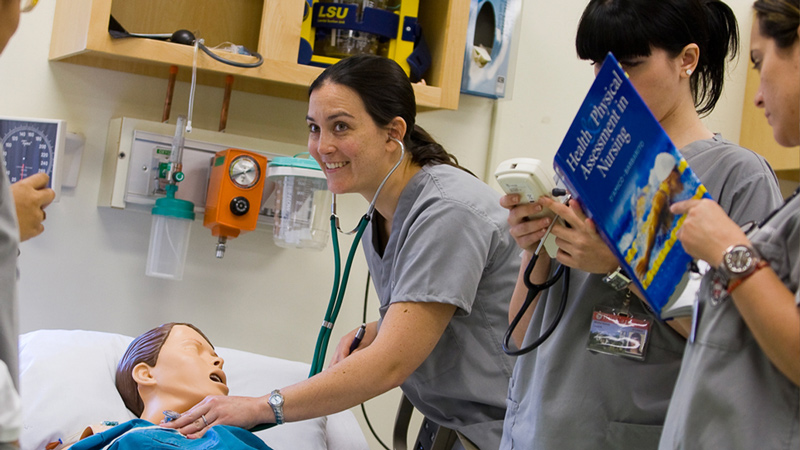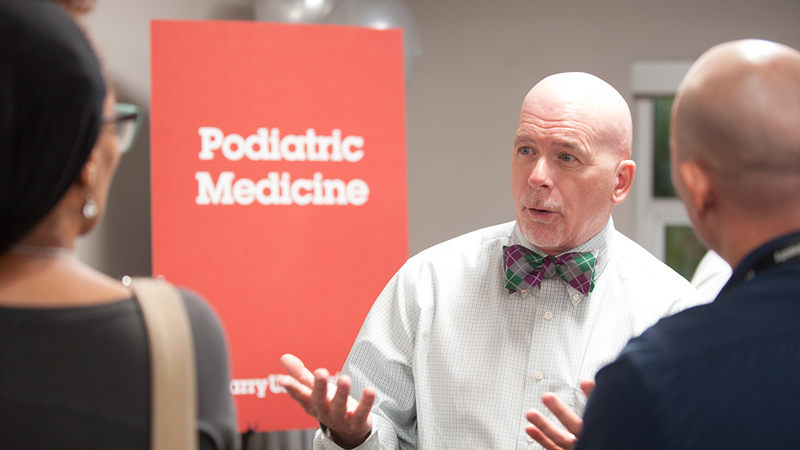Barry University invites the university community to use this website to stay up-to-date with several key initiatives. First, the Institutional Effectiveness Committee (IEC) will provide you with news regarding our assessment program and activities. In addition, the IEC will share information with you on our progress toward preparing for our Southern Association of Colleges and Schools (SACS) Commission on Colleges reaffirmation of accreditation study and visit.
Institutional Effectiveness Committee
-
-
Institutional Effectiveness is the university-specific process that has been implemented to support continuous improvement of all aspects of the University. As a course of action, Institutional Effectiveness serves as the systematic approach for measuring performance against the University’s mission. Institutional Effectiveness includes many things: assessment, strategic and program planning, and resource allocation, to name a few. This comprehensive approach to measuring our outcomes is for use by all aspects of University-life: academic programs, administrative and educational support services, research, and community and public service.
Our accrediting body, the Southern Association of Colleges and Schools Commission on Colleges (SACS-COC), offers this explanation: institutional effectiveness encompasses the extent to which an institution identifies expected outcomes, assesses the extent to which it achieves these outcomes, and provides evidence of improvement based on analysis of the results in each of the following areas: educational programs, to include student learning outcomes; administrative support services; educational support services; research within its educational mission, if appropriate; and community/public service within its educational mission, if appropriate.
Since 2008, the Institutional Effectiveness Committee have been laying the ground work and providing structure for Institutional Effectiveness at Barry University. Although this framework may be new to some, we are now in a position to re-introduce Institutional Effectiveness to the university community, as it will touch every facet of the university life. We feel confident that we have created a strong foundation in order to effectively implement these assessments for the sole purpose of continually enhancing our programs.
-
The Institutional Effectiveness Committee (IEC) is the working body that ensures we are staying on course with SACS – COC accreditation standards, thereby supporting achievement of the University’s Strategic Agenda Goals for 2011-2016.
The IEC is comprised of representatives from every facet of university life Including faculty, staff, and administration – from the main campus and from all of our off campus sites. Since 2008, co-chairs of the Institutional Effectiveness Committee, have been working with the committee to lay the ground work and provide structure for monitoring institutional effectiveness at Barry University.
The IEC is divided into four functional subcommittees: Educational Programs, Administrative Support, Educational Support, and Research/Service.
The IEC, as currently constituted, provides a strong foundation for monitoring and supporting University efforts to develop and assess goal -related outcomes in a way that will lead to continued enhancement of program and service quality.
What We Do
-
Provides a structure for assuring that all areas of the University articulate goals, measure outcomes aligned with the goals, evaluate the effectiveness of goal-related activities, and use assessment results to improve progress toward goal attainment.
-
Serves as the forum for representatives from all areas of Barry University to participate in the coordination and evaluation of assessment activities.
-
Assesses the University’s compliance with the SACS-COC Principles of Accreditation.
-
Promotes ongoing engagement in institutional effectiveness processes, even after SACS reaffirmation.
Who We Are
-
Committee Co-Chairs
Pablo Ortiz, Provost
Yvette Brown Koottungal, VP of Digital Strategies and CIO
IEC Committee Members
Karen Callaghan (Academic Affairs)
Barbara Rodriguez (Academic Affairs)
Anoush McNamee (Academic Affairs)
Nora Pardave (Advancement Services)
Scott Smith (Intercollegiate Athletics and Recreation)
Barry Truesdell (University Administration)
Darrell Duvall (Strategic Initiatives and Digital Strategies)
Debra Pantaleo (Enrollment, Engagement, and Outreach)
Paula Dias (Enrollment, Engagement, and Outreach)
Marnie Peruyera (Business and Finance)
Regional Accreditation
The SACS reaccreditation process is extremely important to our institution. Accreditation by SACS Commission on Colleges signifies that the institution (1) has a mission appropriate to higher education, (2) has resources, programs, and services sufficient to accomplish and sustain that mission, and (3) maintains clearly specified educational objectives that are consistent with its mission and appropriate to the degrees it offers, and that indicate whether it is successful in achieving its stated objectives.
Process of Accreditation
The process for initial and continued accreditation involves a collective analysis and judgment by the institution's internal constituencies, an informed review by peers external to the institution, and a reasoned decision by the elected members of the Commission on Colleges Board of Trustees. Accredited institutions periodically conduct internal reviews involving their administrative officers, staffs, faculties, students, trustees, and others appropriate to the process.
The process for initial and continued accreditation involves a collective analysis and judgment by the institution's internal constituencies, an informed review by peers external to the institution, and a reasoned decision by the elected members of the Commission on Colleges Board of Trustees. Accredited institutions periodically conduct internal reviews involving their administrative officers, staffs, faculties, students, trustees, and others appropriate to the process.
-

Application of The Requirements
The Commission on Colleges bases its accreditation of degree-granting higher education institutions and entities on requirements published in the Principles of Accreditation: Foundations for Quality Enhancement. These requirements apply to all institutional programs and services, wherever located or however delivered. This includes programs offered through distance and correspondence education, off-campus sites, and branch campuses. Consequently, when preparing documents for the Commission demonstrating ompliance with the Principles of Accreditation, an institution must include these programs in its "Institutional Summary Form Prepared for Commission Reviews" and address these programs in its analysis and documentation of compliance. The content on this webpage was copied from the following source: SACS Commission on Colleges (2010) Principles of Accreditation: Foundations for Quality Enhancement Fifth Edition, http://www.sacscoc.org/
SACS Criteria/Standards
Please download this PDF to understand the criteria and standards for the SACS reaffirmation of reaccreditation process.
Outcomes Report
Barry University's academic programs and service units conduct ongoing assessments of various components of our curricula and operations. The Barry University "Outcomes Report" is designed to serve as a synopsis document of any of these assessment activities.
The tool summarizes data about one specific assessment activity: what was assessed and improved, why it was chosen, what benchmark was used to determine an improvement, how often re-assessment occurs, who is responsible for the assessment, and what will be done if an improvement is not working.
The Outcomes Report, as a summary document, is supported by additional tools that provide details about the assessment activity and data collected.
Glossary
-
- Assessment: A systematic and ongoing effort to collect, analyze, and interpret evidence from various sources that describes institutional, departmental, divisional, or program effectiveness, ultimately to improve student learning and development.
- Assessment plan: A document that outlines the student learning outcomes (for academic programs) or unit outcomes (for service units), assessment methods and criteria used to collect evidence related to the attainment of each outcome, and the intervals at which the evidence is collected and reviewed.
- Assessment results: The outcomes that were derived from the measures employed in the Assessment Plan.
- Assessment criterion: A pre-determined standard of performance by which student or service unit performance is evaluated. Criteria support objectivity.
-
- Benchmark: A target or point of reference for measurement. This may include past performance data or data from another comparable internal or external program or service unit. Also, to collect data for use in comparison to similar data studies.
-
- Closing the Loop: To use assessment results to improve a program, department or student learning.
-
- Continuous Improvement: An ongoing effort aimed at improving processes and outcomes. Barry University is committed to the concept of quality enhancement through continuous assessment and improvement. The assessment process is considered cyclic.
-
- Course Map: A tool that helps align the goals and objectives of a course with the expected/planned outcomes.
-
-
- Curriculum Map: A tool that aligns the content, activities, assessments, and resources of a program’s curriculum. The tool documents the process of evaluating a curriculum in relation to its intended outcomes over time. The process is undertaken identify gaps and help ensure that students are receiving learning opportunities that match planned outcomes.
-
-
- Goal: The desired end result after having achieved one or more objectives within a set timeframe. A goal is not the actual result; it is the “hoped for” end result and is, therefore, future oriented
- Program Goals: A global statement that describes the broad, general, intended outcomes of instruction that are further defined by a set of objectives; the general aims or purposes of a program and its curriculum; what you want students to learn. Goals should be broadly stated, meaningful, achievable and assessable. Program goals should reflect Barry University’s mission and strategic initiatives.
- Course Goals: A global statement that describes the broad, general, intended outcomes of instruction that are further defined by a set of objectives; the general aims or purposes of a course and its learning activities; what you want students to learn. Goals should be broadly stated, meaningful, achievable and assessable. Course goals should reflect the program’s purpose and goals.
- Service Unit Goals: A broad, general, statement that describes the intended outcomes of a service unit team’s work processes; what is expected to occur upon completion of a work project. Goals are further defined by a set of objectives. Service unit goals should reflect Barry University’s mission and strategic initiatives.
-
-
- Portfolio: A systematic and organized collection of work over time that is used to demonstrate achievement of a set of identified goals and objectives. A portfolio may serve as evidence of a student learning outcome; it may also serve as evidence of prior learning. Portfolios may contain research papers; tests and exams; case studies; audio or video tapes; computational exercises; scholarly activities; professional, community, fieldwork, and clinical experiences; personal essays, journals, and self-evaluations; and, other original works. Portfolios may exist in hard copy or electronic formats.
-
-
- Objective: specific, measurable, observable terms that should happen at the end of an activity. Objectives are future oriented. Together, multiple objectives inform an overall goal.
- Program Objective: A statement that describes the specific knowledge, skills, and/or values students should exhibit at the completion of a program of study. One or more program objectives should reflect the broader program goal(s). An objective should include: the learner, the behavior, the conditions for performance, and the degree of criterion of success. Bloom’s taxonomy is often used for the verb in an objective.
- Course Objective: A statement that describes the specific knowledge, skills, and/or values students should exhibit at the completion of a course. One or more course objectives should reflect the broader course goal(s). An objective should include: the learner, the behavior, the conditions for performance, and the degree of criterion of success. Bloom’s taxonomy is often used for the verb in an objective.
- Service Unit objective: A statement that describes the specific and measurable work product that should happen upon completion of a designed work process or activity. When grouped with other objectives, these should reflect the achievement of a service unit goal. A service unit objective reflects the area or service that intends to be improved using current resources and personnel and is assessable within a specified period of time.
-
-
- Outcome: The actual, achieved result; a snapshot of the current state of progress.
- Student Learning Outcome (SLO): The actual outcome(s) of instruction that reflect the prescribed set of objectives; the consequence of what has been learned. The three categories of SLOs are cognitive, psychomotor, and affective. Measurement of SLOs provide data for determining whether overall program or course goals are being successfully met and whether students are learning a course or program’s curriculum as specified (based on California Polytechnic)
- Service Unit Outcome (SUO): The actual result or consequence of a work process. SUOs should be under the direct control of the unit and congruent with Barry University’s strategic plan and initiatives. For administrative units, outcomes are primarily process-oriented and demonstrate improved efficiency, effectiveness, and/or financial management. For educational support units, unit outcomes may include both process improvements and student learning outcomes.
-
-
-
- Portfolio: A systematic and organized collection of work over time that is used to demonstrate achievement of a set of identified goals and objectives. A portfolio may serve as evidence of a student learning outcome; it may also serve as evidence of prior learning. Portfolios may contain research papers; tests and exams; case studies; audio or video tapes; computational exercises; scholarly activities; professional, community, fieldwork, and clinical experiences; personal essays, journals, and self-evaluations; and, other original works. Portfolios may exist in hard copy or electronic formats.
-
-
- Purpose: A statement that describes the reason for which a program or service unit exists.
-
- Quality Enhancement Plan (QEP): The QEP is a document created by the Barry University community that evidences a comprehensive and thorough analysis of the effectiveness of our learning environment for supporting student learning and accomplishing our overall mission.
- The QEP:
- includes a process for identifying key issues emerging from institutional assessment
- focuses on learning outcomes and/or the environment supporting student learning and accomplishing the mission of the institution.
- Demonstrates institutional capability for the initiation, implementation, and completion of the QEP.
- Includes broad-based involvement of institutional constituencies in the development and proposed implementation of the QEP.
- Identifies goals and a plan to assess their achievement.
-
- Rubric: A table or grid used in assessment that outlines identified criteria for successfully completing an assignment or task and establishes levels for meeting those criteria. A rubric provides consistency in scoring and defines outcomes and expectations. They may be used to score a variety of learning activities, portfolios, and/or student learning outcomes.
-
- Standard: A measurement or value which indicates the accepted norm. Educational standards are established by the higher education community to address the needs of society and students. They serve as a common denominator of shared values and practices among similar institutions.
-
Xitracs
Xitracs™ is the software platform selected by Barry University to manage all aspects of our ongoing accreditation and compliance process. The tool will be used to produce the final self-study report for submission to SACS and will help track overall progress towards reaccreditation.
Leaders throughout the University will have access to Xitracs in order to run reports, share documents and to see the progression of the certification process.




















